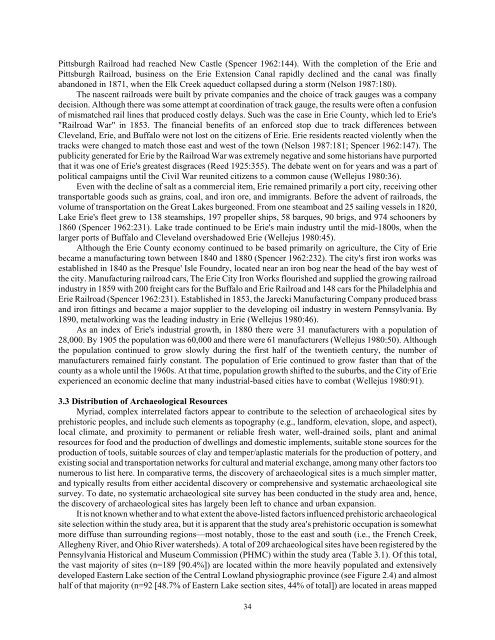Watershed Conservation Plan - Destination Erie
Watershed Conservation Plan - Destination Erie
Watershed Conservation Plan - Destination Erie
You also want an ePaper? Increase the reach of your titles
YUMPU automatically turns print PDFs into web optimized ePapers that Google loves.
Pittsburgh Railroad had reached New Castle (Spencer 1962:144). With the completion of the <strong>Erie</strong> and<br />
Pittsburgh Railroad, business on the <strong>Erie</strong> Extension Canal rapidly declined and the canal was finally<br />
abandoned in 1871, when the Elk Creek aqueduct collapsed during a storm (Nelson 1987:180).<br />
The nascent railroads were built by private companies and the choice of track gauges was a company<br />
decision. Although there was some attempt at coordination of track gauge, the results were often a confusion<br />
of mismatched rail lines that produced costly delays. Such was the case in <strong>Erie</strong> County, which led to <strong>Erie</strong>'s<br />
"Railroad War" in 1853. The financial benefits of an enforced stop due to track differences between<br />
Cleveland, <strong>Erie</strong>, and Buffalo were not lost on the citizens of <strong>Erie</strong>. <strong>Erie</strong> residents reacted violently when the<br />
tracks were changed to match those east and west of the town (Nelson 1987:181; Spencer 1962:147). The<br />
publicity generated for <strong>Erie</strong> by the Railroad War was extremely negative and some historians have purported<br />
that it was one of <strong>Erie</strong>'s greatest disgraces (Reed 1925:355). The debate went on for years and was a part of<br />
political campaigns until the Civil War reunited citizens to a common cause (Wellejus 1980:36).<br />
Even with the decline of salt as a commercial item, <strong>Erie</strong> remained primarily a port city, receiving other<br />
transportable goods such as grains, coal, and iron ore, and immigrants. Before the advent of railroads, the<br />
volume of transportation on the Great Lakes burgeoned. From one steamboat and 25 sailing vessels in 1820,<br />
Lake <strong>Erie</strong>'s fleet grew to 138 steamships, 197 propeller ships, 58 barques, 90 brigs, and 974 schooners by<br />
1860 (Spencer 1962:231). Lake trade continued to be <strong>Erie</strong>'s main industry until the mid-1800s, when the<br />
larger ports of Buffalo and Cleveland overshadowed <strong>Erie</strong> (Wellejus 1980:45).<br />
Although the <strong>Erie</strong> County economy continued to be based primarily on agriculture, the City of <strong>Erie</strong><br />
became a manufacturing town between 1840 and 1880 (Spencer 1962:232). The city's first iron works was<br />
established in 1840 as the Presque' Isle Foundry, located near an iron bog near the head of the bay west of<br />
the city. Manufacturing railroad cars, The <strong>Erie</strong> City Iron Works flourished and supplied the growing railroad<br />
industry in 1859 with 200 freight cars for the Buffalo and <strong>Erie</strong> Railroad and 148 cars for the Philadelphia and<br />
<strong>Erie</strong> Railroad (Spencer 1962:231). Established in 1853, the Jarecki Manufacturing Company produced brass<br />
and iron fittings and became a major supplier to the developing oil industry in western Pennsylvania. By<br />
1890, metalworking was the leading industry in <strong>Erie</strong> (Wellejus 1980:46).<br />
As an index of <strong>Erie</strong>'s industrial growth, in 1880 there were 31 manufacturers with a population of<br />
28,000. By 1905 the population was 60,000 and there were 61 manufacturers (Wellejus 1980:50). Although<br />
the population continued to grow slowly during the first half of the twentieth century, the number of<br />
manufacturers remained fairly constant. The population of <strong>Erie</strong> continued to grow faster than that of the<br />
county as a whole until the 1960s. At that time, population growth shifted to the suburbs, and the City of <strong>Erie</strong><br />
experienced an economic decline that many industrial-based cities have to combat (Wellejus 1980:91).<br />
3.3 Distribution of Archaeological Resources<br />
Myriad, complex interrelated factors appear to contribute to the selection of archaeological sites by<br />
prehistoric peoples, and include such elements as topography (e.g., landform, elevation, slope, and aspect),<br />
local climate, and proximity to permanent or reliable fresh water, well-drained soils, plant and animal<br />
resources for food and the production of dwellings and domestic implements, suitable stone sources for the<br />
production of tools, suitable sources of clay and temper/aplastic materials for the production of pottery, and<br />
existing social and transportation networks for cultural and material exchange, among many other factors too<br />
numerous to list here. In comparative terms, the discovery of archaeological sites is a much simpler matter,<br />
and typically results from either accidental discovery or comprehensive and systematic archaeological site<br />
survey. To date, no systematic archaeological site survey has been conducted in the study area and, hence,<br />
the discovery of archaeological sites has largely been left to chance and urban expansion.<br />
It is not known whether and to what extent the above-listed factors influenced prehistoric archaeological<br />
site selection within the study area, but it is apparent that the study area





